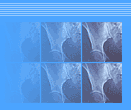| SPALLA
- Diagnostica per immagini |
 |
| C. Masciocchi, A. Barile,
C. Faletti, G. Monetti, F. Rossi |
Author |
| Italian |
Language |
| Gnocchi |
Published by |
| 142 |
Pages |
| 230 |
Images |
| 88-7947-214-3 |
ISBN |
|
 |
Presentation
Inspired by a tremendous amount of iconographic material put
together in more than 10 years of experience in all the different
sections of diagnostic imaging and considering the lack of monographic
texts on the subject in Italian, we have decided to write this
diagnostic treaty on the shoulder.
This book is addressed to all the radiologists with years long
experience, to the radiology associate students who, we hope,
will be able to gain some educational benefits from the reading,
but also to orthopedics, to reumatologists and to anyone with
an active interest in this specific field. The shoulder is an
articulation with a complex anatomy and indeed not easily accessible
with traditional radiology techniques. The new diagnostic imaging
techniques, especially MRI, allow us today to fill in any imaging
"void", giving detailed information on the different
anatomic components.
It should also be pointed out that, if for the knee artroscopy
has "fooled" Diagnostic Imaging, the same cannot be
said for the shoulder. The truth is, for what concerns the shoulder
it is the new Imaging that is making it easier for artroscopy
to be used in the treatment of instability or conflict syndromes.
The book analyzes carefully all the techniques today available
to radiologists, explaining advantages and disadvantages of
each one of them.
We also wanted to broaden the view by analyzing the basic syndromes
on the bases of physiopathology and clinics too. In fact we
believe that every radiologist should be aware of such issues
to be able to make the best use of the methods available today.
In conclusion, the final chapter concentrates on all the pathologies
of the shoulder that are less frequently found but still should
not be considered less important on both the clinic and diagnostic
point of view.
We all wish that this book will be useful to those that have
to face and solve daily clinic-diagnostic problems linked to
shoulder pathologies. If, thanks to a good use of this book,
the radiologist will feel more self-confident in the diagnostic
approach of shoulder pathologies, we will be happy to say we
have achieved our goal.
|

CONTENTS
- Anatomy
- Study technique and RM anatomy
- Conventional radiology
- Outlet view
- Ultrasound Sonography
- Instability
- Conflict Syndromes
- Rotator cuff rupture
- Pathology of the long head of the biceps
- Stap Lesion
- Endoarticular contrastography
- Miscellaneous
- Suggested bibliography
|


